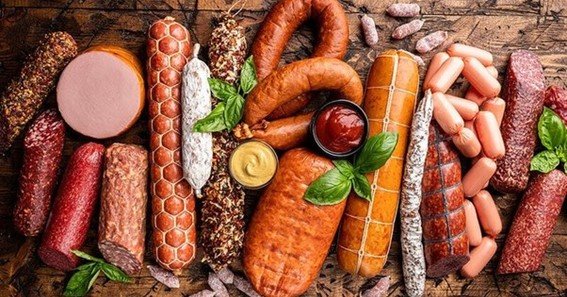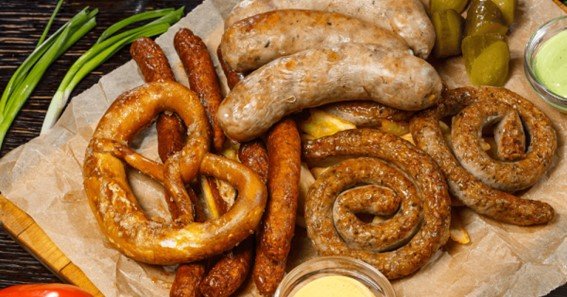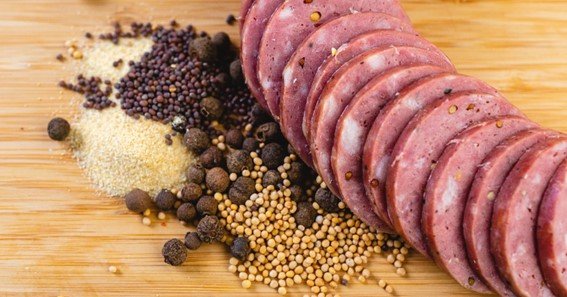What is sausage made of? Sausage is a complex and varied food product from ground meat, fat, and seasonings. Though simple, this inquiry reveals a wonderful world of cooking customs and cuisine. Their simplicity has evolved into a complex and diversified meal.
Knowing how chorizo, bratwurst, and breakfast sausage are created gives you a feel of their lengthy history and countless varieties. This article discusses what is sausage made of, its kinds, their manufacture, their components, and how they taste and feel.
What Is Sausage Made Of?
Basic sausage ingredients include ground pork, lard, and seasonings. Meat is generally the highlight. Beef, pork, chicken, deer, or lamb are other possibilities. Sausage flavor and appearance depend on the meat used. Fat is generally added to keep sausage moist and tender. Taste and moisture depend on fat.
Seasonings and spices are added to meat and fat to make it mild or spicy. Sausage may contain vegetables, herbs, and cheese, depending on the recipe and location. The mixture is then placed in a natural or artificial shell to retain its form during cooking.
Sausage that tastes, feels, and looks nice requires the perfect combination of these ingredients. This was a briefing on what is sausage made of.
Types Of Meat Used In Sausages

After getting to know about what is sausage made of, next is about its types. Each meat used to produce sausages has its distinct flavor. Most sausages are produced using pig because their fat makes them rich and tasty. Italian sausage, bratwurst, and other pork sausages are juicy and flavorful; therefore, people enjoy them.
Beef, especially hot dogs and bangers, is also popular. Beef sausages taste and feel different from pig sausages due to their thinner thickness. Because of their deliciousness and low fat, chicken and turkey sausages are popular.
Specialty sausages produced with lamb or deer are for adventurous eaters. Sausage flavor, texture, and cooking vary by meat type. People pick meat based on diet, local tastes, or culinary traditions.
Role Of Fat In Sausage Making
Fat affects sausage flavor and texture. The fat that keeps sausage wet during cooking makes it creamy and juicier. Sausage is frequently cooked with 20–30% fat and lean meat. Balance is key to sausage taste and avoiding dryness and toughness.
Taste can also be varied by fat type. People adore the richness of traditional sausages made with pork fat. Sausage fat affects texture and taste and lets spices and herbs reach all regions of the meat.
The amount of fat utilized depends on flavor and health. Sausage recipes may be adapted to varied tastes.
Spices And Seasonings In Sausage

Seasonings and spices give sausages their flavors. Using the appropriate spices may make a simple sausage mix taste distinct. Common spices like salt, pepper, garlic, and paprika give meat a good taste.
Sage, thyme, and fennel provide freshness and complexity to cuisine—chili powder, cumin, and cayenne pepper heat chorizo and andouille.
Too much heat might overpower sausage flavors. Pork seasoning requires trying several mixtures until you discover one you like. Some sausages contain cheese, fruit, or vegetables to improve taste and texture.
Natural Vs. Synthetic
Sausage casings are outer layers. It helps produce sausage and binds components. Natural and artificial shells predominate. Natural cases are made from pig or sheep intestines. People enjoy them because they taste traditional and provide texture and bite to sausage.
Open natural casings enable sausage to breathe and cook to the appropriate structure. Shells constructed of collagen or cellulose are synthetic. These are straightforward and always the same thus m; ass manufacturing uses them.
Hot dogs and breakfast sausages use collagen casings from processed animal skins. Plant-based cellulose casings are removed before eating. Depending on the recipe, you pick a casing that affects the sausage’s appearance and texture.
Different Ways To Cook Sausage
Sausage tastes and looks different when cooked in different ways—many grill sausage to give it a smokey, burnt flavor and drain fat. Sausages are cooked evenly on a BBQ or grill by turning them occasionally.
Another popular method is to flip sausages in a skillet with butter or oil. The surface gets crispy, and the interior stays juicy when preparing breakfast sausages or bratwurst in this manner. When producing several sausages at once, baking is a hands-off method. Before grilling or serving, hot dogs are boiled to ensure they are thoroughly cooked.
Choose a cooking procedure based on the sausage and your tastes. The method employed can modify the sausage’s taste and appearance, demonstrating its versatility.
Conclusion
To conclude, What is sausage made of? reveals a complex gastronomic history and regional diversity. Sausages contain meat, fat, and seasonings. They can have natural or manufactured casings and be cooked differently for distinct flavors and textures. Sausages are versatile and popular worldwide.
Italy makes them with langoustines, whereas the US and UK use pork. Sausage products and processes reflect local tastes and customs. Thus, each sausage represents a culture. Knowing what goes into a sausage lets us enjoy it more and reveals how inventive and competent its makers are. This was a brief article on what is sausage made of.
FAQ
What Is The Origin Of Sausage?
Ground beef, fat, spices, and sometimes herbs, cheese, or vegetables are used to make sausage. The combination is cooked inside a natural or man-made shell to form a pleasant and useful meal.
What Meat Does Sausages Contain?
For a unique taste, you may prepare sausages from pig, beef, chicken, turkey, and even lamb or deer. Varied meats give sausage varied flavors and textures.
How Does Fat Affect Sausage Making?
Sausage needs fat to flavor and preserve it. It keeps the meat tender and juicy when cooking and improves sausage flavor and texture.
What Are The Difference Between Natural And Artificial Casings?
Natural animal gut shells are preferred for their vintage appearance and feel. Collagen or cellulose shells are stable and convenient to employ for bulk manufacture.
How To Prepare Sausages?
Depending on the type and desired effect, sausage can be grilled, pan-fried, baked, or boiled. Diverse cooking processes produce crispy, peppery, soft, and creamy flavors and textures.
Sources:
https://www.ilporcellinodenver.com/blogs/bills-blog/what-is-sausage










